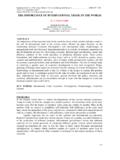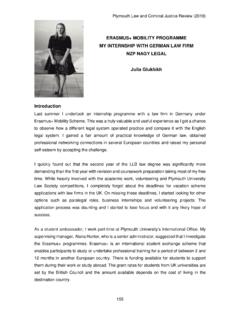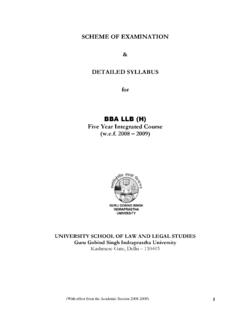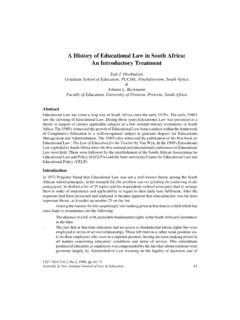Transcription of The Integration of Beneficiaries of International ...
1 The Integration of Beneficiaries of International / humanitarian protection into the labour Market: Policies and Good Practices 1. INTRODUCTION This EMN Inform summarises the findings from the EMN Study on the Integration of Beneficiaries of International / humanitarian protection into the labour Market: Policies and Good Practices .1 The Study was based on contributions from EMN National Contact Points in 24 Member States2, collected via a common template to ensure comparability. The key findings are set out below. 2. KEY POINTS TO NOTE: The significant rise in asylum applications lodged in the EU in recent years, in combination with a higher recognition rate, has placed the Integration of Beneficiaries of International / humanitarian protection at the top of the political agenda. Results of the EU labour Force Survey show, however, that the labour market participation rate of Beneficiaries is low, especially in the first four or less years of residence.
2 On the other hand, Beneficiaries employment rate increases over time and after 20+ years the employment rate becomes almost the same for all categories of migrants. 1 Available from the EMN website 2 Austria, Belgium, Bulgaria, Croatia, Cyprus, Czech Republic, Estonia, Finland, France, Germany, Greece, Hungary, Italy, Ireland, Latvia, Although Beneficiaries are, in all Member States, granted the legal right to access the labour market, administrative requirements and practical obstacles specific to the situation of Beneficiaries impede access in practice. Member States provide Beneficiaries access to a wide range of employment-related support measures. Significant differences exist however across Member States as to the organisation, the type/content of the measures, the extent to which they are tailored to Beneficiaries , as well as the extent to which they are accessible in practice.
3 The large majority of Member States apply a mainstreaming approach and provide access to employment-related support measures in a similar manner to all TCNs. Several others apply a hybrid approach by combining generic measures for migrants with specific tailored measures to Beneficiaries , whereas only few provide specific measures tailored exclusively to Beneficiaries . Core measures provided by most Member States include language courses, orientation services, employment services (including counselling), housing assistance, and assistance in obtaining recognition of professional qualifications. Lithuania, Luxembourg, Malta, the Netherlands, Slovenia, Slovak Republic, Spain, Sweden, United Kingdom. 2 The precise focus of these courses and nature of the services still differs significantly across Member States.
4 The majority of employment-related support measures are generic ( similar as those offered to TCNs/nationals), but the Study crucially shows an increasing trend of policy initiatives to develop more tailored measures in response to the current migration/refugee crisis. Most of these have however yet to be translated into specific measures/practices in the coming years. Good practices in the provision of employment-related support measures include: - Linking language learning to the job market; - Providing orientation services with the aim to directly support workplace Integration ; - Provision of tailored measures to facilitate Beneficiaries access to education; - Provision of complementary education and training (bridging courses) specifically for Beneficiaries or TCNs; - Provision of tailored vocational educational training; - Provision of employment counselling by a wide range of actors and in different foreign languages; - Provision of tailored schemes for the recognition of qualifications and accreditation of prior learning, including tailored information and assistance.
5 - Provision of additional/tailored housing assistance to Beneficiaries ; Despite availability of a wide range of employment-related services, Beneficiaries face numerous obstacles to access these in practice. Some employment-related support measures are not widely available to all Beneficiaries ( offered on a project basis, restricted to geographical areas etc.). Other factors which impede participation in support measures include financial costs (both direct and indirect), lack of language proficiency, low educational levels, lack of educational qualifications and/or documents to proof qualifications etc. Additionally, due to high financial and human resource costs, the implementation of support measures is in some Member States also sub-optimal. Certain differences in the treatment between the various categories of Beneficiaries exist.
6 The main difference between refugees and Beneficiaries of subsidiary protection relates to the length of the residence permit with many Member States granting residence permits of shorter duration to Beneficiaries of subsidiary protection . Also, Beneficiaries of humanitarian protection are in some Member States subject to more administrative conditions in comparison to refugees/ Beneficiaries of subsidiary protection . 3. AIMS OF THE STUDY The overall aim of the Study was to present a comparative analysis of Member States policies and practices to facilitate the labour market Integration of Beneficiaries of International / humanitarian protection . The Study addresses: labour market access rights in legislation as well as in practice; The availability and type of employment-related support measures; Identification of good practices and obstacles in Member States policies and practices to realise labour market access and participation of Beneficiaries ; Differences in the treatment of the different statuses (refugee, beneficiary of subsidiary protection , humanitarian protection ).
7 4. BACKGROUND/CONTEXT TO THE STUDY Why is labour market Integration of Beneficiaries so important (background/context to the Study)? labour market Integration is a key concern for Beneficiaries , Member States and a successful EU, including an effective protection system for Beneficiaries of International protection . From the perspective of refugees, having a job is one of the most important factors for successful Integration as it fosters feelings of pride to provide for oneself, facilitates acceptance by the wider society, and supports refugees with other dimensions of Integration . From the perspective of Member States, labour market participation of Beneficiaries can also reduce costs associated with the welfare system. In a context of ageing populations and labour shortages, Member States also face the challenge to make optimal use of the labour force present on their territory.
8 3 Most crucially, the current context with migratory challenges and the growing number of Beneficiaries also underlines the importance of labour market Integration of refugees. The EU Action Plan on the Integration of third-country nationals underlined this when it stated: national economic and social policies will need to cater for the recent inflow of third-country migrants and refugees. This will be a challenge for many Member States, but with the right conditions [..] it is also an opportunity, especially for Member States undergoing demographic changes. That includes on the economic front as evidence shows that third-country nationals have a positive fiscal net contribution if they are well integrated in a timely manner, starting with early Integration into education and the labour market3.
9 How is the EU currently faring when it comes to labour market participation of Beneficiaries of International protection ? Statistics on labour market participation of Beneficiaries are scarce and very little empirical research has been done. Nevertheless, the 2014 European Union labour Force Survey indicates that participation rates of Beneficiaries are low (only 27%) in the first four or less years of residence, but that these increase over time. After 20+ years of residence the employment rate becomes almost the same for all categories of migrants. Moreover, most Member States indicated that those Beneficiaries who do secure employment usually work below their qualification level and hold low-skilled/low-paid jobs of temporary nature. This illustrates that more could and should be done to ensure more effective labour market Integration of Beneficiaries .
10 5. labour MARKET ACCESS RIGHTS IN LEGISLATION AND PRACTICE To what extent are Beneficiaries confronted with obstacles (in legislation and in practice) when accessing the labour market? As required by the recast Qualification Directive (QD), all Member States grant Beneficiaries of International protection the legal right to employment. Although the recast QD requires Member States to immediately authorise Beneficiaries access to the labour market, in practice, certain administrative conditions first have to be met. For example, all Member States except Croatia require Beneficiaries to be in possession of a residence permit, whereas some (AT4, BE5, EL6, ES, MT, SE) also require a separate work permit. Whilst the procedure including the length of time it takes to obtain such documents differs per Member State, requirements such as these can delay the process of accessing the labour market.










